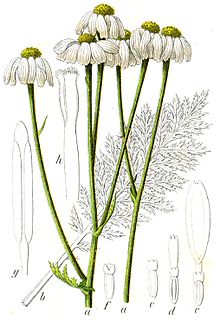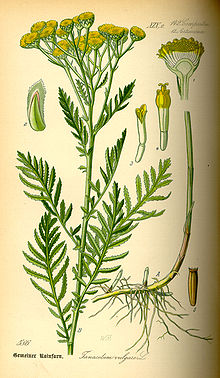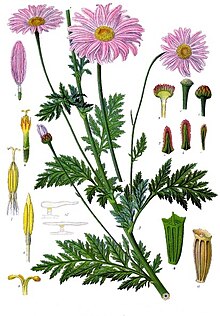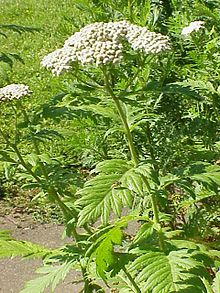Wild flowers
| Wild flowers | ||||||||||||
|---|---|---|---|---|---|---|---|---|---|---|---|---|

Feverfew ( Tanacetum parthenium ) |
||||||||||||
| Systematics | ||||||||||||
|
||||||||||||
| Scientific name | ||||||||||||
| Tanacetum | ||||||||||||
| L. |
The tanacetum ( Tanacetum ) are a genus of flowering plants in the family of the daisy family (Asteraceae). The 150 to 160 species thrive in the temperate areas of the northern hemisphere .
description


Vegetative characteristics
Tanacetum styles are mostly perennial , rarely annual , herbaceous plants or rare half bushes or shrubs . Many species lignify to a greater or lesser extent at their base. They form rhizomes as persistence organs. They are mostly aromatic plants.
The alternate leaves are stalked or sessile. The leaf blades are rarely simple, they are usually pinnate.
Generative characteristics
Are predominantly of cup-shaped part inflorescences (often in the form of a composite Schirmrispe ) total inflorescences , rarely a single basket-shaped inflorescence is present only. The flower heads have a diameter of rarely 3 to, usually 5 to over 22 millimeters. The (rarely 20 to) usually 30 to more than 60 bracts are in (rarely two) usually three to five rows. Chaff sheets are not available. The flower heads contain 10 to over 21 ray-flowers and 60 to over 300 tubular flowers. The mostly female, fertile or sterile ray florets are white or yellow. The hermaphroditic, fertile tubular flowers are yellow.
The achenes are usually five to ten ribs (four to over twelve ribs). The pappus consists of only one membranous, crown-shaped border; there is rarely no pappus.
Sets of chromosomes
The basic chromosome number is x = 9. Polyploidy is often present.







ingredients
Pyrethrum
The insecticide pyrethrum is obtained from the dried flowers of Tanacetum species by crushing or extraction with solvents. The "Montenegro or Dalmatian pyrethrum" is selected from the Dalmatian insect flower , insect repellent herb ( Tanacetum cinerariifolium , Syn. : Chrysanthemum cinerariifolium , pyrethrum cinerariifolium ), however, the "Armenian, Persian or Caucasian insect repellent" from the Caucasian insect flower ( Tanacetum coccineum , Syn. : Chrysanthemum coccineum , Pyrethrum roseum , Pyrethrum carneum ). The Pyrethrum species were a genus of their own, but are now part of the Tanacetum genus .
Plants that supply pyrethrum are preferably grown in or exported from Africa (e.g. Tanzania , Kenya ), Central America (e.g. Ecuador , Colombia ), New Guinea and Japan .
Systematics and distribution
The genus Tanacetum was established by Carl von Linné in 1753 . Synonyms for Tanacetum L. are: Balsamita Mill. , Gymnocline Cass. , Pyrethrum med. , Pyrethrum tin , Spathipappus Tzvelev .
The main distribution area of the genus Tanacetum is in the Holarctic . The Tanacetum species thrive in the temperate latitudes of the northern hemisphere in Eurasia , North Africa and North America . Some species are grown worldwide.
There are 150 to 160 species of Tanacetum (selection):
- Tanacetum abrotanifolium (L.) Druce (Syn .: Achillea abrotanifolia L. ): It occurs in Turkey , Armenia and Iran .
- Tanacetum achilleifolium (M.Bieb.) Sch.Bip. (Syn .: Chrysanthemum achilleifolium (M.Bieb.) Kuntze , Pyrethrum achilleifolium M.Bieb. ): It occurs in Romania , Bulgaria , Ukraine , Russia , the Caucasus and Kazakhstan .
- Tanacetum artemisioides Sch.Bip. ex Hook. f. : It occurs in Pakistan, in western Xizang at altitudes between 2400 and 2700 meters above sea level and possibly also in India.
- Tanacetum atkinsonii (CBClarke) Kitam. (Syn .: Chrysanthemum atkinsonii C.B. Clarke ): It occurs in Bhutan , Sikkim , Nepal and Tibet .
-
Lady mint or balsam herb ( Tanacetum balsamita L. ): The home is Turkey , Iraq , Iran , Armenia , Azerbaijan and Georgia . In Europe, in North and South America it is cultivated and is a neophyte .
- Tanacetum balsamita L. subsp. balsamita (Syn .: Balsamita major Desf. , Chrysanthemum balsamita auct., Chrysanthemum majus (Desf.) Asch. , Pyrethrum majus (Desf.) Tzvelev ): The homeland is Turkey, Iran, Azerbaijan, Armenia and Georgia.
- Tanacetum balsamita subsp. balsamitoides (Sch.Bip.) Grierson (Syn .: Chrysanthemum balsamita L. , Pyrethrum balsamita (L.) Willd. , Tanacetum balsamitoides Sch.Bip. ): The home is Turkey, Iraq, Iran and Armenia.
- Tanacetum bipinnatum (L.) Sch.Bip. (Syn .: Chrysanthemum bipinnatum L. ): It is widespread in Russia from the European part to Siberia and the Far Eastern part of Russia and is also found in Alaska .
- Tanacetum camphoratum Less. (Syn .: Tanacetum douglasii DC. ): It occurs in North America in British Columbia , Oregon , Washington and California .
- Dalmatian insect flower or ash-leaf exuberant flower ( Tanacetum cinerariifolium (Trevir.) Sch.Bip. , Syn .: Chrysanthemum cinerariifolium (Trevir.) Vis. , Pyrethrum cinerariifolium Trevir. ): Home is Croatia , Albania , Bosnia , Herzegovina and Montenegro . In the rest of Europe and Cyprus it is a neophyte.
- Tanacetum chitralense (Podlech) K.Bremer & Humphries : It is endemic to Pakistan (Chitral) and occurs there at altitudes between 3000 and 4000 meters above sea level.
- Red-flowered wild flower or Armenian insect flower ( Tanacetum coccineum (Willd.) Grierson , Syn .: Chrysanthemum coccineum Willd. , Chrysanthemum marshalii Asch. Ex O. Hoffm . , Chrysanthemum roseum Adams , Pyrethrum carneum M.Bieb. , Pyrethrum roseum (Adams) M. Bieb. ): The homeland is Turkey, Iran, the Caucasus, Armenia, Georgia and Azerbaijan .
-
Bouquet-flowered exuberance or ebony exuberance ( Tanacetum corymbosum (L.) Sch.Bip. , Chrysanthemum corymbosum L. , Pyrethrum corymbosum (L.) Willd. ): There are subspecies (only a selection here):
- Tanacetum corymbosum (L.) Sch.Bip. subsp. corymbosum (Syn .: Chrysanthemum corymbosum L. , Pyrethrum corymbosum (L.) Willd. ): It occurs in Europe, in the temperate areas of Asia and in Algeria and Morocco .
- Tanacetum corymbosum subsp. subcorymbosum (Schur) Pawł. (Syn .: Tanacetum corymbosum subsp. Clusii (fish. Ex Rchb.) Heywood , Pyrethrum clusii fish. Ex Rchb. ): It occurs in Poland , Austria , Hungary , Slovakia , Romania , Ukraine, Croatia , Slovenia as well as in Bosnia and Herzegovina.
- Tanacetum emodi R.Khan : It occurs in Pakistan and Xizang at altitudes between 3000 and 4100 meters above sea level.
- Tanacetum falconeri Hook. f. : It occurs in Himachal Pradesh , in Pakistan and in western Xizang at altitudes between 2000 and 4000 meters.
- Tanacetum griffithii (CBClarke) Muradyan : It occurs in Central Asia, Afghanistan, Pakistan, in the Himalayas and in Xizang.
- Tanacetum huronense Nutt. (Syn .: Tanacetum pauciflorum Richardson ): The home is Canada, Wisconsin, Maine and Michigan.
- Large-leaved exuberant flower ( Tanacetum macrophyllum (Waldst. & Kit.) Sch. Bip. , Syn .: Chrysanthemum macrophyllum Waldst. & Kit. ): The home is Southeastern Europe, Turkey and the Caucasus.
- Ball tansy ( Tanacetum niveum (Lag.) Sch.Bip. , Syn .: Pyrethrum niveum Lag. ): The home is the Caucasus region.
- Tanacetum pakistanicum Podlech : It is endemic to Pakistan.
- Tanacetum parthenifolium (Willd.) Sch.Bip. (Syn .: Pyrethrum parthenifolium Willd. ): The homeland is the Crimea , West and Central Asia and the Caucasus.
- Feverfew ( Tanacetum parthenium (L.) Sch.Bip. , Syn .: Chrysanthemum parthenium (L.) Bernh. , Chrysanthemum praealtum Vent. , Leucanthemum parthenium (L.) Gren. & Godr. , Matricaria eximia hort. Ex Voss nom. inval., Matricaria parthenium L. ): The home is southern Europe, Turkey, the Crimea, the Czech Republic and the Caucasus. In many other countries the species is a neophyte.
- Tanacetum pinnatum Boiss. : It occurs in Turkey, Iraq and Iran.
-
Tanacetum polycephalum Sch.Bip. : There are subspecies (selection):
- Tanacetum polycephalum subsp. argyrophyllum (K.Koch) Podlech (Syn .: Gymnocline argyrophylla K.Koch , Tanacetum argyrophyllum (K.Koch) Tzvelev ): It occurs in Turkey, Iraq and Iran, Armenia and Azerbaijan.
- Tanacetum polycephalum Sch. Gdp. subsp. polycephalum : It occurs in Turkey, Iraq and Iran.
- Tanacetum poteriifolium (Ledeb.) Grierson (Syn .: Chrysanthemum anserinifolium (Hausskn. & Bornm.) JWIngram & Dress , Pyrethrum anserinifolium Hausskn. & Bornm. , Pyrethrum poteriifolium Ledeb. ): It occurs in Turkey and in the Caucasus.
- Tanacetum ptarmiciflorum (Webb & Berthel.) Sch.Bip. (Syn .: Chrysanthemum ptarmiciflorum (Webb & Berthel.) Brenan , Pyrethrum ptarmiciflorum Webb & Berthel. ): This endemic occurs only in Gran Canaria .
- Tanacetum roylei (DC.) R.Khan : This endemic only occurs in Kashmir .
- Tanacetum stoliczkae (CBClarke) R.Khan : It occurs only in Kashmir at altitudes between 3000 and 4000 meters above sea level.
- Common tansy ( Tanacetum vulgare L. , Syn .: Chrysanthemum vulgare (L.) Bernh. , Tanacetum boreale Fisch. Ex DC. ): It is widespread in Eurasia and is a neophyte in numerous other countries.
No longer belonging to the genus Tanacetum (selection):
- Tanacetum axillare Thunb. → Asaemia minuta (L. f.) K.Bremer
- Tanacetum incanum L. → Artemisia incana (L.) Druce
- Tanacetum lingulatum (Boiss.) Bornm. → Xylanthemum lingulatum (Boiss.) K.Bremer & Humphries
- Tanacetum potentilloides (A.Gray) A.Gray → Sphaeromeria potentilloides (A.Gray) A.Heller
- Tanacetum purpureum Buch.-Ham. ex D.Don → Cyathocline purpurea (Buch.-Ham. ex D.Don) Kuntze
- Tanacetum serotinum (L.) Sch.Bip. → Leucanthemella serotina (L.) Tzvelev
- Tanacetum simplex A. Nelson → Sphaeromeria simplex (A. Nelson) A. Heller
- Tanacetum suffruticosum L. → Oncosiphon suffruticosum (L.) Källersjö
- Tanacetum waldsteinii Sch.Bip. → Leucanthemum waldsteinii (Sch.Bip.) Pouzar
swell
- Tanacetum at Tropicos.org. In: Flora of Pakistan . Missouri Botanical Garden, St. Louis
- Linda E. Watson: Tanacetum , pp. 489-490 - the same text online as the printed work , In: Flora of North America Editorial Committee (Ed.): Flora of North America North of Mexico. Volume 19: Magnoliophyta: Asteridae, part 6: Asteraceae, part 1 (Mutisieae – Anthemideae). Oxford University Press, New York and Oxford, 2006, ISBN 0-19-530563-9 .
- Zhu Shi, Christopher J. Humphries, Michael G. Gilbert: Tanacetum , pp. 763-765 - online with the same text as the printed work , In: Wu Zheng-yi, Peter H. Raven, Deyuan Hong (ed.): Flora of China. Volume 20-21: Asteraceae. Science Press and Missouri Botanical Garden Press, Beijing and St. Louis, 2011, ISBN 978-1-935641-07-0 .
Individual evidence
- ↑ a b c Linda E. Watson: Tanacetum , pp. 489-490 - online with the same text as the printed work , In: Flora of North America Editorial Committee (ed.): Flora of North America North of Mexico. Volume 19: Magnoliophyta: Asteridae, part 6: Asteraceae, part 1 (Mutisieae – Anthemideae). Oxford University Press, New York and Oxford, 2006, ISBN 0-19-530563-9 .
- ^ Tanacetum at Tropicos.org. Missouri Botanical Garden, St. Louis, accessed February 18, 2018.
- ↑ a b c d e f g h i j k l m n o p q r s t u v w x y z aa ab ac ad ae af ag Tanacetum in the Germplasm Resources Information Network (GRIN), USDA , ARS , National Genetic Resources Program. National Germplasm Resources Laboratory, Beltsville, Maryland. Retrieved January 13, 2019.
- ↑ a b Zhu Shi, Christopher J. Humphries, Michael G. Gilbert: Tanacetum Linnaeus. , Pp. 763-765 - online with the same text as the printed work , In: Wu Zheng-yi, Peter H. Raven, Deyuan Hong (ed.): Flora of China. Volume 20-21: Asteraceae. Science Press and Missouri Botanical Garden Press, Beijing and St. Louis, 2011, ISBN 978-1-935641-07-0 .
- ↑ a b c d e f Flora of Pakistan. Vol. 207 & 210. Tanacetum - online.
- ↑ Werner Greuter (2006+): Compositae (pro parte majore). In: W. Greuter, E. von Raab-Straube (Ed.): Compositae. : Datasheet Tanacetum In: Euro + Med Plantbase - the information resource for Euro-Mediterranean plant diversity.
Web links
- Tanacetum at Tropicos.org. In: IPCN Chromosome Reports . Missouri Botanical Garden, St. Louis
- Tanacetum at Tropicos.org. In: Flora Mesoamericana . Missouri Botanical Garden, St. Louis
- Flora list of Baden-Württemberg . ( Memento from August 30, 2008 in the Internet Archive )
